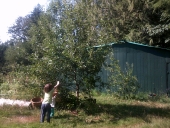
 3
3












quite the opposite . we had a very wet late spring early summer and the winter was a lot warmer than the 2 before it. i just talked to my neighbor who also has a lot of berry bushes and fruit trees also and he's noticed they are lacking at his place also. we aren't near any cities or even big towns so i can't blame it on pollution. i should be looking at a huge crop of elderberries by next month but all the flowers are falling with no little green berry starting to grow! i sat in front of those bushes for a half hr. on a nice calm sunny day and i didn't see one bee or butterfly land on those huge flower clusters! just the sweet smell should bring in at least a few! its very disturbing!Casie Becker wrote:My first thought was to see if you'd had an unusually cold winter. The reports I'm finding suggest otherwise. The next thing I looked at was the drought conditions. Are you in one of the areas suffering from drought, right now?




 2
2












 1
1




Invasive plants are Earth's way of insisting we notice her medicines. Stephen Herrod Buhner
Everyone learns what works by learning what doesn't work. Stephen Herrod Buhner




Invasive plants are Earth's way of insisting we notice her medicines. Stephen Herrod Buhner
Everyone learns what works by learning what doesn't work. Stephen Herrod Buhner
 4
4




Moderator, Treatment Free Beekeepers group on Facebook.
https://www.facebook.com/groups/treatmentfreebeekeepers/









 1
1








Invasive plants are Earth's way of insisting we notice her medicines. Stephen Herrod Buhner
Everyone learns what works by learning what doesn't work. Stephen Herrod Buhner












Invasive plants are Earth's way of insisting we notice her medicines. Stephen Herrod Buhner
Everyone learns what works by learning what doesn't work. Stephen Herrod Buhner




 1
1




Invasive plants are Earth's way of insisting we notice her medicines. Stephen Herrod Buhner
Everyone learns what works by learning what doesn't work. Stephen Herrod Buhner




 3
3




 I'm wondering if the ozone layer has gotten a lot worse than even science claims. Are they afraid to tell us?
I'm wondering if the ozone layer has gotten a lot worse than even science claims. Are they afraid to tell us? 




Living a life that requires no vacation.




$10.00 is a donation. $1,000 is an investment, $1,000,000 is a purchase.








A human being should be able to change a diaper, plan an invasion, butcher a hog, conn a ship, design a building, write a sonnet, balance accounts, build a wall, set a bone, comfort the dying, take orders, give orders, cooperate, act alone, solve equations, analyze a new problem, pitch manure, program a computer, cook a tasty meal, fight efficiently, die gallantly. Specialization is for insects.
-Robert A. Heinlein




 1
1








Becky Proske wrote:For a long time, Arthur Firstenberg, author of the book: The Invisible Rainbow, has been sharing research about the impacts of electromagnetic fields on people, wildlife and insects from around the world. Thank you.
JayGee

| I agree. Here's the link: http://stoves2.com |




